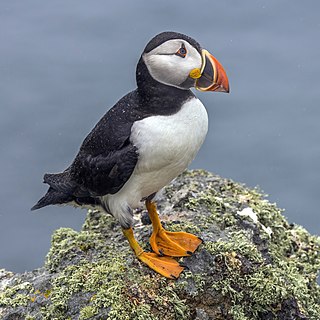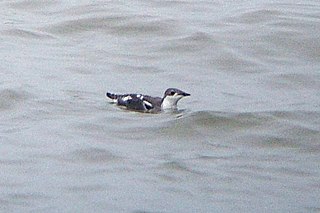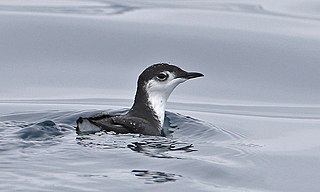
Procellariiformes is an order of seabirds that comprises four families: the albatrosses, the petrels and shearwaters, and two families of storm petrels. Formerly called Tubinares and still called tubenoses in English, procellariiforms are often referred to collectively as the petrels, a term that has been applied to all members of the order, or more commonly all the families except the albatrosses. They are almost exclusively pelagic, and have a cosmopolitan distribution across the world's oceans, with the highest diversity being around New Zealand.

An auk or alcid is a bird of the family Alcidae in the order Charadriiformes. The alcid family includes the murres, guillemots, auklets, puffins, and murrelets. The family contains 25 extant or recently extinct species that are divided into 11 genera.

Seabirds are birds that are adapted to life within the marine environment. While seabirds vary greatly in lifestyle, behaviour and physiology, they often exhibit striking convergent evolution, as the same environmental problems and feeding niches have resulted in similar adaptations. The first seabirds evolved in the Cretaceous period, and modern seabird families emerged in the Paleogene.

The Atlantic puffin, also known as the common puffin, is a species of seabird in the auk family. It is the only puffin native to the Atlantic Ocean; two related species, the tufted puffin and the horned puffin are found in the northeastern Pacific. The Atlantic puffin breeds in Russia, Iceland, Ireland, Norway, Greenland, Newfoundland and Labrador, Nova Scotia, and the Faroe Islands, and as far south as Maine in the west and France in the east. It is most commonly found in the Westman Islands, Iceland. Although it has a large population and a wide range, the species has declined rapidly, at least in parts of its range, resulting in it being rated as vulnerable by the IUCN. On land, it has the typical upright stance of an auk. At sea, it swims on the surface and feeds on zooplankton, small fish, and crabs, which it catches by diving underwater, using its wings for propulsion.

The pigeon guillemot is a species of bird in the auk family, Alcidae. One of three species in the genus Cepphus, it is most closely related to the spectacled guillemot. There are five subspecies of the pigeon guillemot; all subspecies, when in breeding plumage, are dark brown with a black iridescent sheen and a distinctive wing patch broken by a brown-black wedge. Its non-breeding plumage has mottled grey and black upperparts and white underparts. The long bill is black, as are the claws. The legs, feet, and inside of the mouth are red. It closely resembles the black guillemot, which is slightly smaller and lacks the dark wing wedge present in the pigeon guillemot.

The razorbill, razor-billed auk, or lesser auk is a North Atlantic colonial seabird and the only extant member of the genus Alca of the family Alcidae, the auks. It is the closest living relative of the extinct great auk.

The common murre, also called the common guillemot or foolish guillemot,(Uria aalge) is a large auk. It has a circumpolar distribution, occurring in low-Arctic and boreal waters in the North Atlantic and North Pacific. It spends most of its time at sea, only coming to land to breed on rocky cliff shores or islands.

The marbled murrelet is a small seabird from the North Pacific. It is a member of the family Alcidae, which includes auklets, guillemots, murres and puffins. It nests in old-growth forests or on the ground at higher latitudes where trees cannot grow. The marbled murrelet has declined in number since humans began logging its nest trees in the latter half of the 19th century. The decline of the marbled murrelet and its association with old-growth forests, at least in the southern part of its range, have made it a flagship species in the forest preservation movement.

The parakeet auklet is a small seabird of the North Pacific. Parakeet Auklets used to be placed on its own in the genus Cyclorrhynchus but recent morphological and genetic evidence suggest it should be placed in the genus Aethia, making them closely related to crested auklets and least auklets. It is associated with the boreal waters of Alaska, Kamchatka and Siberia. It breeds on the cliffs, slopes and boulder fields of offshore islands, generally moving south during the winter.

Cassin's auklet is a small, chunky seabird that ranges widely in the North Pacific. It is the only species placed in the genus Ptychoramphus. It nests in small burrows and because of its presence on well studied islands in British Columbia and off California it is one of the better known auks. It is named for the American ornithologist John Cassin.

The long-billed murrelet is a small seabird from the North Pacific. The genus name Brachyramphus is from Ancient Greek brakhus, "short", and rhamphos, "bill". The species name perdix is Latin for "partridge" Pallas described this auk as Magnitudine Perdicis. "Murrelet" is a diminutive of "murre", a word of uncertain origins, but which may imitate the call of the common guillemot.

The Guadalupe murrelet or Xantus's murrelet is a small seabird found in the California Current system in the Pacific Ocean. This auk breeds on islands off California and Mexico. It is threatened by predators introduced to its breeding colonies and by oil spills.

The least auklet is a seabird and the smallest species of auk. It is the most abundant seabird in North America, and one of the most abundant in the world, with a population of around nine million birds. They breed on the islands of Alaska and Siberia, and spend the winter close to the edge of the ice sheet. Their largest colonies are on the Aleutian Islands, St. Lawrence Island and Little Diomede Island.

The sooty albatrosses are small albatrosses from the genus Phoebetria. There are two species, the sooty albatross, Phoebetria fusca, and the light-mantled albatross, Phoebetria palpebrata.

The Japanese murrelet or crested murrelet is a small seabird in the auk family that occurs along the remote rocky coasts and in the offshore waters of Japan, and may also be found after the breeding season as far as Sakhalin to the north and in particular off South Korea. With a small and declining population, estimated as of 2017 to total 2,500–10,000 individuals, it is the rarest alcid, and the most at risk of extinction.

Craveri's murrelet is a small seabird which breeds on offshore islands in both the Pacific Ocean and the Gulf of California off the Baja peninsula of Mexico. It also wanders fairly regularly as far as central California in the US, primarily during post-breeding dispersal. It is threatened by predators introduced to its breeding colonies, by oil spills, and by tanker traffic. Increasing tourism development and commercial fishing fleets also further threaten the species. With an estimated population of 6,000-10,000 breeding pairs, its population is listed as vulnerable.

Brachyramphus is a small genus of seabirds from the North Pacific. Brachyramphus is from Ancient Greek brakhus, "short", and rhamphos, "bill". In English the species are named as "murrelets"; this is a diminutive of "murre", a word of uncertain origins, but which may imitate the call of the common guillemot.

Austral storm petrels, or southern storm petrels, are seabirds in the family Oceanitidae, part of the order Procellariiformes. These smallest of seabirds feed on planktonic crustaceans and small fish picked from the surface, typically while hovering. Their flight is fluttering and sometimes bat-like.

Scripps's murrelet is a small seabird found in the California Current system in the Pacific Ocean. This auk breeds on islands off California and Mexico. It is threatened by predators introduced to its breeding colonies and by oil spills.



















